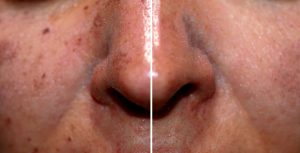Laser Skin Resurfacing
 Laser skin resurfacing is a noninvasive and nontoxic therapy that makes use of light energy for repairing and regenerating skin cells. The procedure improves the results of treated skin conditions and reduces the need for medication. It also increases the recovery rate of affected skin tissues.
Laser skin resurfacing is a noninvasive and nontoxic therapy that makes use of light energy for repairing and regenerating skin cells. The procedure improves the results of treated skin conditions and reduces the need for medication. It also increases the recovery rate of affected skin tissues.
Texas Surgical Dermatology, led by board certified dermatologist Dr. Tri H. Nguyen, provides laser skin resurfacing treatments for sun damage removal to patients in Houston, Katy, Spring, The Woodlands, Texas, and surrounding locations.
Benefits of Laser Therapy for Sun Damaged Skin
- Increased cellular energy in the treatment area
- Reduced need for pain medications in the treatment area
- Improved immune response
- Improved response to healing
- Collagen promotion for new skin production
- Reduced swelling because of better lymphatic drainage
- Reduced inflammation
- Improved blood circulation in the treatment area
Treating Sun Damage with Lasers
Laser skin resurfacing treatment can be used for stimulating collagen formation and tissue renewal by injuring the skin in a controlled fashion. High energy light beams in a single color are emitted by lasers. Lasers have specific molecular targets unlike sunlight that has a wider light spectrum. Target molecules are in the from of melanin, hemoglobin, and water for skin resurfacing lasers.
- IR light is absorbed by water. Longer IR rays are absorbed strongly by the skin and don’t make it past the upper dermis and epidermis. The shorter IR rays reach the lower dermis without damaging superficial layers.
- Hemoglobin is the pigment responsible for turning the blood red. It absorbs visible light, especially green-yellow light.
- Melanin is the main epidermal pigment that absorbs visible UV and IR rays. Lasers that emit short IR rays are absorbed weakly. This makes them suitable for all skin colors.
- The differences in the molecules distribution and interactions explains precision of laser therapy.
Healing is promoted by the process by increasing production of enzymes, collagen, and cell growth. Scar tissue is prevented from forming with the increased collagen production.
Ablative Lasers
Ablative lasers, such as erbium YAG lasers and carbon dioxide (CO2) lasers emit long IR waves. These can vaporize superficial skin cells. They also cause more inflammation as compared to their non-ablative counterparts. Ablative lasers produce more dramatic and superior results. They are suitable for severe lesions, such as actinic keratoses and deep wrinkles.
Non-Ablative Lasers
Intense pulsed light (IPL), pulsed dye laser (PDL), and non-ablative Fraxel laser are types of non-ablative lasers. The light beams hit deeper skin targets while leaving the epidermis intact. The results are modest and gradual. They are less effective for treating severely sun-damaged skin.
What to Expect Following the Procedure
You may not see any notable changes for a few weeks following the procedure. Other concerns may include:
- Treated area may turn red or pink for 4 – 8 hours following the treatment.
- You may experience a slight stinging sensation like mild sunburn. The sensation should subside within 4 – 6 hours. Moist cloth or cool packs can be applied for reducing the sensation.
- Mild swelling may take a few days for dissipating.
Patients should use a good moisturizing lotion on the treated area twice daily. Texas Surgical Dermatology, led by board certified dermatologist Dr. Tri H. Nguyen receives patients from Houston, Katy, Spring, The Woodlands, Texas, and nearby areas for laser skin resurfacing treatments to remove sun damage.
For More Information contact our Board Certified in Dermatologists at Texas Surgical Dermatology in Spring, TX
For more information on procedures and treatments offered at Texas Surgical Dermatology PA please call 832.663.6566 or click here to contact our dermatologists. Helping patients in Houston, The Woodlands, Spring, Katy and other surrounding areas of Texas.

